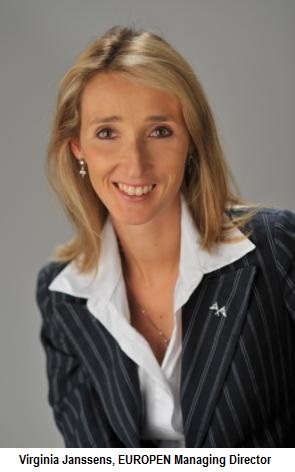Enabling a competitive and resource-efficient Circular Economy
 The EU institutions have promised ambitious policy goals towards a Circular Economy in Europe. The related policy review aims to set an enabling EU policy framework while not being too prescriptive respecting the sovereignty of the 28 Member States in moving towards a sustainable and growth oriented European economy. A resource restrained Europe urges us all to use our resources in a more secure, smarter and competitive way and make our production and consumption more sustainable. The means to these overarching goals will be different for Member States, business sectors and consumer life styles.
The EU institutions have promised ambitious policy goals towards a Circular Economy in Europe. The related policy review aims to set an enabling EU policy framework while not being too prescriptive respecting the sovereignty of the 28 Member States in moving towards a sustainable and growth oriented European economy. A resource restrained Europe urges us all to use our resources in a more secure, smarter and competitive way and make our production and consumption more sustainable. The means to these overarching goals will be different for Member States, business sectors and consumer life styles.
An optimised EU policy framework would further unleash the potential of packaging as part of the solution in enabling a resource efficient and competitive circular economy, underpinned by the economies of scale provided by the Internal Market, which is the backbone principle of the EU. The packaging supply chain from raw material suppliers, packaging converters to brand owners, represented by EUROPEN, is therefore fully engaged in the related policy debate and has identified key guidelines and recommendations of which some are highlighted in this article.
As a general principle, respecting the life-cycle approach (LCA) along packaged product value chains in existing and future EU policy should remain a key priority. A life-cycle approach ensures net environmental improvements, taking into account trade-offs as changes in one part of the value chain will inevitably affect another part. For packaging, changing the type, weight and design of packaging solely based on the end of the pack’s useful life may negatively impact the pack’s ability to protect, preserve and market a particular product. This is why policy-makers should continue to consider packaging in the context of the product it contains. This holistic approach is appropriately reflected in the EU Packaging and Packaging Waste Directive (PPWD), which is part of the current legislative review. A life cycle analysis will for instance lead to the result that certain used packaging types cannot be recycled at reasonable cost or due to technical, infrastructure or safety reasons. In this case energy recovery should remain a viable option where the recovered energy can be used to power a.o. manufacturing plants or the local grid.
We caution against one size fits all regulatory solutions across all the concerned EU laws which address different products, sectors and/or waste streams which all have different legal bases, policy and business needs. For instance, common prescriptive measures related to sourcing, product design or end-of-life for a washing machine, smartphone or packaging will not necessarily deliver more resource efficiency or achieve the EU’s Circular Economy objectives for all. Tailored regulatory approaches, such as for packaging and packaging waste in the PPWD, are still needed.
 A key driver for a circular economy is Extended Producer Responsibility (EPR); an end of life tool applied in 25 Member States to help them reach EU and national recycling and recovery targets for used packaging. One of the key opportunities now where EU policy can support is by setting binding EU minimum performance requirements for EPR to increase transparency, accountability and enforcement of national packaging waste management. A strengthened EU regulatory framework for EPR is needed to address market changes and failures and policy gaps in the implementation and enforcement of separate collection and sorting of used packaging. Levelling the playing field among existing EPR schemes (both for profit and non for profit models), will alleviate the compliance burden on producers and aid Member States to help meet legal targets at the lowest sustainable cost to society. Improved EPR will ultimately deliver more quality secondary raw materials which can be re-injected into the manufacturing process; the essence of a Circular Economy.
A key driver for a circular economy is Extended Producer Responsibility (EPR); an end of life tool applied in 25 Member States to help them reach EU and national recycling and recovery targets for used packaging. One of the key opportunities now where EU policy can support is by setting binding EU minimum performance requirements for EPR to increase transparency, accountability and enforcement of national packaging waste management. A strengthened EU regulatory framework for EPR is needed to address market changes and failures and policy gaps in the implementation and enforcement of separate collection and sorting of used packaging. Levelling the playing field among existing EPR schemes (both for profit and non for profit models), will alleviate the compliance burden on producers and aid Member States to help meet legal targets at the lowest sustainable cost to society. Improved EPR will ultimately deliver more quality secondary raw materials which can be re-injected into the manufacturing process; the essence of a Circular Economy.
EPR should be implemented according to national conditions and based on defined roles and responsibilities for each and all actors involved in national packaging waste management. A strengthened legal framework for EPR will also provide public and private actors with the necessary legal predictability and security to make long-term investments in for instance more efficient packaging waste management infrastructure and innovative packaging solutions in (secondary) raw materials along with their supply chain partners.
By answering multiple challenges spanning the life of the product for which it is designed (e.g. product protection, food waste prevention, extending a product’s shelf-life, consumer safety, convenience, information needs and also end-of-life considerations), packaging is vital to our modern societies and life styles. These functionalities of packaging should be further acknowledged, along with efforts to continuously improve the end-of-life considerations for used packaging. Further investments and innovation in our industry require a balanced, sustainable and growth-oriented EU policy framework that increases the global competitiveness of industry in Europe and enables more job generation.
Read more on EUROPEN’s policy recommendations for a competitive, resource-efficient and growth-oriented Circular Economy here.
***
Note: This article was published in the Adjacent Government Magazine on 27 August 2015, the full issue can be consulted here